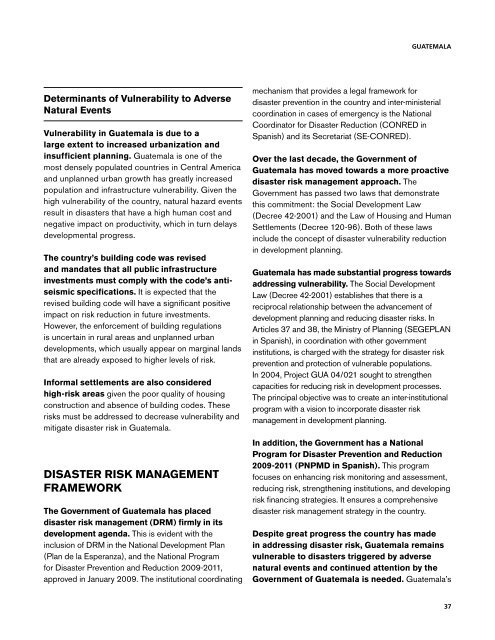Disaster Risk Management in Central America: GFDRR Country Notes
Disaster Risk Management in Central America: GFDRR Country Notes
Disaster Risk Management in Central America: GFDRR Country Notes
You also want an ePaper? Increase the reach of your titles
YUMPU automatically turns print PDFs into web optimized ePapers that Google loves.
guatemala<br />
Determ<strong>in</strong>ants of Vulnerability to Adverse<br />
Natural Events<br />
Vulnerability <strong>in</strong> Guatemala is due to a<br />
large extent to <strong>in</strong>creased urbanization and<br />
<strong>in</strong>sufficient plann<strong>in</strong>g. Guatemala is one of the<br />
most densely populated countries <strong>in</strong> <strong>Central</strong> <strong>America</strong><br />
and unplanned urban growth has greatly <strong>in</strong>creased<br />
population and <strong>in</strong>frastructure vulnerability. Given the<br />
high vulnerability of the country, natural hazard events<br />
result <strong>in</strong> disasters that have a high human cost and<br />
negative impact on productivity, which <strong>in</strong> turn delays<br />
developmental progress.<br />
The country’s build<strong>in</strong>g code was revised<br />
and mandates that all public <strong>in</strong>frastructure<br />
<strong>in</strong>vestments must comply with the code’s antiseismic<br />
specifications. It is expected that the<br />
revised build<strong>in</strong>g code will have a significant positive<br />
impact on risk reduction <strong>in</strong> future <strong>in</strong>vestments.<br />
However, the enforcement of build<strong>in</strong>g regulations<br />
is uncerta<strong>in</strong> <strong>in</strong> rural areas and unplanned urban<br />
developments, which usually appear on marg<strong>in</strong>al lands<br />
that are already exposed to higher levels of risk.<br />
Informal settlements are also considered<br />
high-risk areas given the poor quality of hous<strong>in</strong>g<br />
construction and absence of build<strong>in</strong>g codes. These<br />
risks must be addressed to decrease vulnerability and<br />
mitigate disaster risk <strong>in</strong> Guatemala.<br />
disaster risk management<br />
framework<br />
The Government of Guatemala has placed<br />
disaster risk management (DRM) firmly <strong>in</strong> its<br />
development agenda. This is evident with the<br />
<strong>in</strong>clusion of DRM <strong>in</strong> the National Development Plan<br />
(Plan de la Esperanza), and the National Program<br />
for <strong>Disaster</strong> Prevention and Reduction 2009-2011,<br />
approved <strong>in</strong> January 2009. The <strong>in</strong>stitutional coord<strong>in</strong>at<strong>in</strong>g<br />
mechanism that provides a legal framework for<br />
disaster prevention <strong>in</strong> the country and <strong>in</strong>ter-m<strong>in</strong>isterial<br />
coord<strong>in</strong>ation <strong>in</strong> cases of emergency is the National<br />
Coord<strong>in</strong>ator for <strong>Disaster</strong> Reduction (CONRED <strong>in</strong><br />
Spanish) and its Secretariat (SE-CONRED).<br />
Over the last decade, the Government of<br />
Guatemala has moved towards a more proactive<br />
disaster risk management approach. The<br />
Government has passed two laws that demonstrate<br />
this commitment: the Social Development Law<br />
(Decree 42-2001) and the Law of Hous<strong>in</strong>g and Human<br />
Settlements (Decree 120-96). Both of these laws<br />
<strong>in</strong>clude the concept of disaster vulnerability reduction<br />
<strong>in</strong> development plann<strong>in</strong>g.<br />
Guatemala has made substantial progress towards<br />
address<strong>in</strong>g vulnerability. The Social Development<br />
Law (Decree 42-2001) establishes that there is a<br />
reciprocal relationship between the advancement of<br />
development plann<strong>in</strong>g and reduc<strong>in</strong>g disaster risks. In<br />
Articles 37 and 38, the M<strong>in</strong>istry of Plann<strong>in</strong>g (SEGEPLAN<br />
<strong>in</strong> Spanish), <strong>in</strong> coord<strong>in</strong>ation with other government<br />
<strong>in</strong>stitutions, is charged with the strategy for disaster risk<br />
prevention and protection of vulnerable populations.<br />
In 2004, Project GUA 04/021 sought to strengthen<br />
capacities for reduc<strong>in</strong>g risk <strong>in</strong> development processes.<br />
The pr<strong>in</strong>cipal objective was to create an <strong>in</strong>ter-<strong>in</strong>stitutional<br />
program with a vision to <strong>in</strong>corporate disaster risk<br />
management <strong>in</strong> development plann<strong>in</strong>g.<br />
In addition, the Government has a National<br />
Program for <strong>Disaster</strong> Prevention and Reduction<br />
2009-2011 (PNPMD <strong>in</strong> Spanish). This program<br />
focuses on enhanc<strong>in</strong>g risk monitor<strong>in</strong>g and assessment,<br />
reduc<strong>in</strong>g risk, strengthen<strong>in</strong>g <strong>in</strong>stitutions, and develop<strong>in</strong>g<br />
risk f<strong>in</strong>anc<strong>in</strong>g strategies. It ensures a comprehensive<br />
disaster risk management strategy <strong>in</strong> the country.<br />
Despite great progress the country has made<br />
<strong>in</strong> address<strong>in</strong>g disaster risk, Guatemala rema<strong>in</strong>s<br />
vulnerable to disasters triggered by adverse<br />
natural events and cont<strong>in</strong>ued attention by the<br />
Government of Guatemala is needed. Guatemala’s<br />
37
















